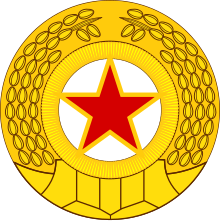Korean People’s Army
| Korean People's Army | |
|---|---|
|
|

|
|

Emblem of the Korean People's Army.
|
|
| Founded | 25 April 1932 (claimed) 8 February 1947 (current form) |
| Service branches | |
| Headquarters | Pyongyang, North Korea |
| Leadership | |
| Marshal Kim Jong-un | |
| General Ri Yong-gil | |
| Vice Marshal Ri Myong-su | |
| Manpower | |
| Conscription | 17 years of age |
| Available for military service |
6,515,279 males, age 15-29 (2010), 6,418,693 females, age 15-29 (2010) |
| Fit for military service |
4,836,567 males, age 15-29 (2010), 5,230,137 females, age 15-29 (2010) |
| Reaching military age annually |
207,737 males (2010), 204,553 females (2010) |
| Active personnel | 1,190,000 (2012) (ranked 4th) |
| Reserve personnel |
600,000 reserves (2012) 5,889,000 paramilitary (2012) (ranked 1st) |
| Expenditures | |
| Budget | ~$10 billion |
| Percent of GDP | ~25% |
| Industry | |
| Domestic suppliers | |
| Annual exports | $100 million |
| Related articles | |
| History |
Korean War Korean DMZ Conflict Vietnam War Yom Kippur War Syrian Civil War |
| Ranks | Comparative military ranks of Korea |
| Korean People's Army | |
| Chosŏn'gŭl | |
|---|---|
| Hancha | |
| Revised Romanization | Joseon Inmingun |
| McCune–Reischauer | Chosŏn Inmingun |
The Korean People's Army (KPA; Chosŏn'gŭl: 조선인민군; Chosŏn inmin'gun) constitutes the military force of North Korea and, under the Songun policy, the central institution of North Korean society. Kim Jong-un is the Supreme Commander of the Korean People's Army and Chairman of the Central Military Commission. The KPA defence force consists of five branches: Ground Force, the Navy, the Air Force, the Strategic Rocket Forces, and the Special Operation Force. The Worker-Peasant Red Guards also come under control of the KPA.
The KPA faces its primary adversaries, the Republic of Korea Armed Forces and United States Forces Korea, across the Korean Demilitarized Zone, as it has since the Armistice Agreement of July 1953. As of 2016[update], with 5,889,000 paramilitary personnel, it is the largest paramilitary organization on Earth. This number represents 25% of the North Korean population.
...
Wikipedia
